Nancy Larsen didn’t get her first dog until 2002, the year she retired from teaching in the Robbinsdale School District.
That first canine companion—a Shih Tzu named Heidi—lived for 15 years, helping to keep Larsen active and social in her Minneapolis neighborhood every day. Treating Heidi’s late-onset diabetes also became part of the routine, and served as a constant reminder for Larsen to look after her own health.
So a few years ago when her veterinarian called about a rescue Havanese with diabetes in need of a home, Larsen, who lives alone, was quick to take him in and fill the void she had experienced since losing her first dog.
“I think the biggest thing, because I’ve been retired now all these years, is change and loss,” says Larsen, 71. “Because I’ve lost all of my family members. And having no children, having a dog kind of fills that empty space. Plus I could take care of Henry. Someone said to me, ‘Nancy, when Heidi died you lost a job.’ And so I got another job taking care of Henry. I’m kind of a caregiver so it made me feel good.”
The research behind the health benefits of interacting with animals is plentiful. From exercise to companionship to relief from stress and depression, animals can make a big impact on our quality of life, says Rebecca Johnson, a professor and director of the Research Center for Human-Animal Interaction at the University of Missouri College of Veterinary Medicine. And you don’t have to own a pet to reap the wellness rewards.
MORE THAN FLUFF
Animal interaction is so powerful because it engages four of our five senses—sight, sound, smell, and touch—simultaneously.
“In most health care, there are no other interventions where four are engaged at one time,” Johnson says. “That’s assuming people view the animal as positive stimulus.”
That last part is important, as obvious as it seems. Animals on their own won’t improve an individual’s health—the person needs to have a positive association. Simply put, if you don’t like a particular animal, avoid it, Johnson says.
“And there are people who shouldn’t have animals because they don’t like animals and animals don’t benefit them and that’s OK,” she says. But for those who do have an animal affection—whether it’s for dogs, cats, bunnies, reptiles, or any number of other creatures—the sensory overload leads to some potent reactions.
When we smell, see, hear and touch an animal, the vagus nerve, the longest cranial nerve in the body, is stimulated, Johnson says. Heart rate, respiratory rate and blood pressure decrease, and that’s because of what’s called the parasympathetic nervous system, which is enacted by the stimulation of these senses.
Powerful hormones are then released. Oxytocin makes us feel happy, while prolactin helps us feel nurturing, Johnson says. Cortisol, the stress hormone, is suppressed.
“That’s the physiologic basis for why all this works,” Johnson says. “It isn’t just that they’re cute and fluffy. It’s that all of these senses are engaged with these powerful hormones being released. It really has quite amazing effects on the body.”
Wendy Hitch, 68, of Minnetonka, sees the sensory impact in action every day with her therapy dog, Getty. Hitch, co-founder of North Star Therapy Animals, takes Getty to hospitals, rehabilitation centers, schools, libraries, and elsewhere every day to help others.
“I like to think that we are the source of a ripple,” Hitch says. “People seeing Getty and smiling—it’s the whole ripple effect of somebody seeing somebody connecting and interacting. They don’t even have to do it. They can be allergic to dogs but they can sit there all day and watch Getty be pet, do tricks, get treats, and get so much pleasure out of it.”
OUT AND ABOUT
Though other animals can help us get exercise through play and interaction, dog walking is perhaps the most commonly studied form of animal-related physical activity. In Johnson’s research, individuals who walked dogs regularly were more likely to maintain body function during a three-year period than those who didn’t have or walk a dog.
A 2017 Swedish study of over 3.4 million people published in Scientific Reports found that dog ownership reduced the risk of death from cardiovascular disease, thanks to social support and motivation for physical activity.
Hitch, though focused daily on the needs of others, acknowledges that her health has also benefited from activities with Getty.
“I wake up every day with things to do, places to go, people expecting me—well expecting my dog—and I know that I’m going to make a difference,” Hitch says. “She’s going to make a difference.”
Hitch also participates in agility classes and other events with Getty that keep them both moving and socially engaged with others. Johnson says studies have found that people are more likely to talk to someone with a companion animal and pet owners are quick to reciprocate, sharing photos, etc.
“You can look at and talk about your pet with someone even when you can’t talk to them about other things,” Johnson says.
Larsen says she knows her neighbors for blocks around because of her daily walks with Heidi and Henry and the conversations they sparked. Beyond the exercise and interactions, she also says caring for a dog with diabetes has given her pause about her own diet and maintaining her health. Henry was blind in one eye and in very rough shape when Larsen took him in. Three years later, you’d never guess he had a chronic condition.
“He needed me and I needed him,” Larsen says. “Sometimes it’s a mutual need. Those things make you feel good. And I think he’s feeling really good, too. He’s enjoying life every day and so am I.”



